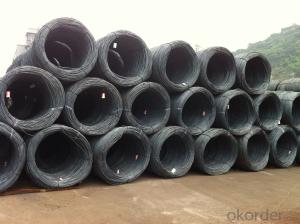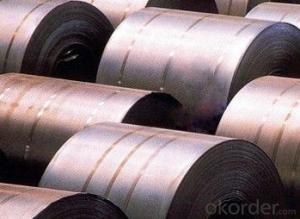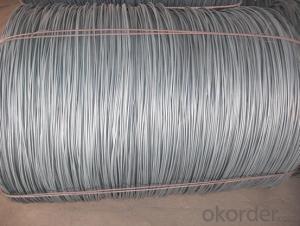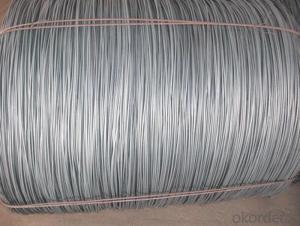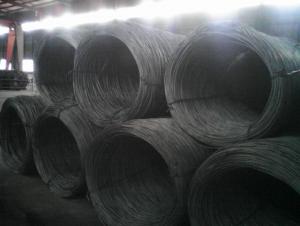Steel Wire Rod 6.5mm
- Loading Port:
- China Main Port
- Payment Terms:
- TT OR LC
- Min Order Qty:
- -
- Supply Capability:
- -
OKorder Service Pledge
OKorder Financial Service
You Might Also Like
Specifications of Steel Wire Rod in Coil:
Steel Grade: Q195/235, SAE1006-1018B Standard: ASTM, GB
Diameter: 6.5mm
Type: Drawn Wire Alloy or Not: Alloy Brand Name: HSKY
Technique: Hot Rolled Place of Origin: China Mainland
Chemical Composition:(Please kindly find our chemistry of our material based on SAE1006B and SAE1008B as below for your information)
Grade | Chemical Composition (%) | |||||
C | Mn | S | P | Si | B | |
SAE1006B | 0.03~O.07 | 0.32max | 0.045max | 0.040max | 0.30max | 0.0008min |
Mechanical properties | ||||||
Yield strength(N/mm2) | Tensile strength(N/mm2) | Elongation (%) | ||||
250-280 | 350-380 | ≥32 | ||||
Grade | Chemical Composition (%) | |||||
C | Mn | S | P | Si | B | |
SAE1008B | 0.10max | 0.3~0.50 | 0.050max | 0.040 max | 0.15max | 0.0008 min |
Mechanical properties | ||||||
Yield strength(N/mm2) | Tensile strength(N/mm2) | Elongation (%) | ||||
≥195 | 315-430 | ≥30 | ||||
- Q:What are the standard impact strength requirements for steel wire rod?
- The standard impact strength requirements for steel wire rod can vary depending on the specific application and industry standards. However, in general, steel wire rod is expected to possess good impact strength properties to ensure its durability and resistance to breakage under dynamic loading conditions. The impact strength requirements are typically defined by various international standards organizations such as ASTM International, ISO (International Organization for Standardization), and national standards bodies. These standards provide guidelines for determining the impact strength of steel wire rod through standardized testing methods. To meet the standard impact strength requirements, steel wire rod is often subject to impact tests like Charpy or Izod tests. These tests involve striking a notched sample of the wire rod with a pendulum hammer, measuring the energy absorbed during fracture. The results provide a measure of the material's ability to withstand sudden shock or impact. The specific impact strength requirements for steel wire rod can vary depending on factors such as the intended application, industry regulations, and customer specifications. For example, wire rod used in construction may have different impact strength requirements compared to wire rod used in automotive manufacturing. In conclusion, the standard impact strength requirements for steel wire rod are determined by international and national standards organizations and can vary depending on the application. Meeting these requirements ensures that the wire rod possesses the necessary strength and resilience to withstand impact and dynamic loading conditions.
- Q:How are steel wire rods used in the manufacturing of screws and bolts?
- Steel wire rods are used in the manufacturing of screws and bolts as they provide the raw material for shaping and forming these fasteners. The rods are typically cold drawn or hot rolled to produce the required diameter and length for the specific screw or bolt size. They are then cut, threaded, and heat-treated to enhance their strength and durability. Finally, the rods are further processed to create the screw or bolt head, ensuring a secure and reliable fastening solution.
- Q:How is steel wire rod used in the manufacturing of wire for suspension systems in trains?
- Steel wire rod is a crucial component in the manufacturing process of wire for suspension systems in trains. The suspension system of a train is responsible for maintaining stability, reducing vibrations, and ensuring a smooth ride for passengers. Steel wire rod is used to create the wire that forms the backbone of these suspension systems. Firstly, steel wire rod is processed through a series of hot rolling, cold drawing, and heat treatment techniques to achieve the desired strength and flexibility. This process allows the wire to withstand the high forces and constant stress experienced by the suspension system during train operation. Once the steel wire rod has been transformed into wire, it is further processed to create the specific suspension components required for train suspension systems. The wire is typically shaped into coil springs, helical springs, or torsion bars, depending on the specific design and requirements of the suspension system. Coil springs are commonly used in train suspension systems to absorb shocks and vibrations caused by uneven tracks or sudden changes in speed. These springs are made by winding the steel wire rod into a tightly coiled shape, which enables them to compress and expand as needed, providing the necessary support and cushioning. Helical springs, on the other hand, are used to support the weight of the train and maintain proper ride height. They are created by twisting the steel wire rod into a helix shape, which allows them to bear the load while offering flexibility and damping properties. Torsion bars, another type of suspension component, are used to resist twisting forces and provide stability. They are made by shaping the steel wire rod into a solid bar, which is then installed horizontally across the train's suspension system. As the train moves, the torsion bars twist, resisting the forces that would otherwise cause the train to tilt or sway. In summary, steel wire rod plays a vital role in the manufacturing of wire for suspension systems in trains. Through various processing techniques, it is transformed into wire and shaped into coil springs, helical springs, or torsion bars. These suspension components provide stability, absorb shocks and vibrations, and ensure a smooth and comfortable ride for passengers.
- Q:What are the factors affecting the price of steel wire rods?
- The price of steel wire rods can be affected by several factors, including: 1. Supply and demand dynamics: The equilibrium between the supply and demand of steel wire rods in the market plays a significant role in determining their prices. When demand surpasses supply, prices tend to rise. Conversely, an excess supply can lead to price reductions. 2. Raw material expenses: The costs associated with raw materials like iron ore and coal, which are essential for manufacturing steel wire rods, can directly impact their prices. Price fluctuations in these inputs can influence the overall production cost and, consequently, the price of steel wire rods. 3. Energy expenditure: The energy-intensive nature of steel production means that variations in energy prices, such as electricity and fuel costs, can have a substantial effect on the price of steel wire rods. Higher energy expenses can increase production costs and result in higher prices for the end product. 4. Currency exchange rates: The international trade of steel wire rods makes them susceptible to currency exchange rate changes. If the currency of a steel-producing country weakens against other currencies, it can enhance their export competitiveness, potentially leading to lower prices in the global market. 5. Government policies and regulations: Government policies, including tariffs, import/export restrictions, and environmental regulations, can impact the price of steel wire rods. Trade barriers can restrict the supply from specific regions, leading to higher prices. Additionally, stricter environmental regulations can raise production costs, which can be passed on to consumers as higher prices. 6. Technological advancements: Advances in technology and production techniques can influence the manufacturing cost of steel wire rods. More efficient production methods can reduce costs and potentially lower prices. However, significant investments in new technologies or higher quality products may result in price increases. In summary, the price of steel wire rods is influenced by market forces, input costs, government policies, and technological advancements. A comprehensive understanding of these factors is crucial for industry participants and consumers to make informed decisions and anticipate price fluctuations in the steel wire rod market.
- Q:What are the different types of coatings used on steel wire rod?
- There are several different types of coatings that can be used on steel wire rods. Some common examples include zinc coatings, which provide corrosion resistance; copper coatings, which enhance conductivity; and polymer coatings, which offer protection against abrasion and wear. Other types of coatings may include aluminum, tin, or nickel, depending on the specific application and desired properties.
- Q:How is steel wire rod used in the manufacturing of wire for heating elements?
- Steel wire rod is an essential component in the manufacturing of wire for heating elements. It serves as the primary raw material used to create the wire that forms the heating element. The process starts with high-quality steel wire rod that is carefully selected based on its specific properties and characteristics. This rod is then subjected to a series of manufacturing processes to transform it into wire suitable for heating elements. First, the steel wire rod is carefully drawn through a series of dies to reduce its diameter. This drawing process helps to refine the wire and achieve the desired diameter and uniformity. It also improves the mechanical properties of the wire, ensuring it can withstand the high temperatures and stresses that heating elements are subjected to. Next, the wire is typically subject to annealing, which involves heating it to high temperatures and then slowly cooling it. This process helps to relieve any internal stresses in the wire and improve its ductility, making it easier to work with during the subsequent steps of manufacturing. Once the wire has been drawn and annealed, it is further processed to add any necessary coatings or surface treatments. These coatings can provide additional protection against corrosion, enhance the wire's electrical conductivity, or improve its heat resistance, depending on the specific requirements of the heating element. Finally, the wire is spooled onto large reels, ready to be used in the manufacturing of heating elements. These spools of wire can then be further processed and shaped to create the specific design required for the heating element, whether it be a coil, ribbon, or other form. Overall, steel wire rod plays a crucial role in the manufacturing of wire for heating elements. It serves as the foundation for creating the wire that will ultimately generate heat in a wide range of applications, from household appliances to industrial equipment. Its high-quality properties, combined with the careful manufacturing processes it undergoes, ensure that the wire meets the strict requirements for performance, durability, and safety in heating element applications.
- Q:How does the tensile strength of steel wire rod vary with different grades?
- The tensile strength of steel wire rod can vary significantly with different grades. The grade of steel refers to its composition and the specific properties it possesses. Generally, higher grade steel wire rods have higher tensile strength. Different grades of steel wire rod contain varying amounts of carbon, manganese, silicon, and other elements. The composition of the steel influences its strength, hardness, and other mechanical properties. Steel wire rods with higher carbon content, for example, tend to have higher tensile strength. Additionally, the manufacturing process used to produce steel wire rod can also affect its tensile strength. The steel can be subjected to various heat treatment processes such as quenching and tempering, which can further enhance its strength. In summary, the tensile strength of steel wire rod varies with different grades due to differences in composition and manufacturing processes. Higher grade steel wire rods generally have higher tensile strength, allowing them to withstand greater forces and pressures.
- Q:What are the different types of steel wire rod coatings used for corrosion resistance?
- For corrosion resistance, various types of coatings are commonly utilized on steel wire rods. These coatings serve as a protective barrier against moisture and chemicals that may cause corrosion. The most commonly employed coatings include: 1. Zinc Coating: Widely used, the zinc coating, known as galvanization, involves applying a layer of zinc to the wire rod's surface. By acting as a sacrificial anode, the zinc corrodes before the steel wire rod, thus safeguarding it against corrosion. 2. Epoxy Coating: Epoxy coatings are ideal for steel wire rods exposed to harsh environments or chemicals. These coatings offer exceptional corrosion resistance and can endure high temperatures. The application of epoxy coatings usually involves electrostatic spray deposition. 3. Polymer Coating: Polymer coatings are a popular choice for corrosion resistance. They are typically crafted from thermoplastic or thermosetting materials and can be applied through dipping, spraying, or extrusion. Polymer coatings create a durable and flexible barrier against moisture and chemicals. 4. Ceramic Coating: Ceramic coatings are suitable for steel wire rods exposed to extreme temperatures or abrasive environments. These coatings provide excellent corrosion resistance, as well as high thermal and chemical stability. Ceramic coatings are typically applied using thermal spraying. 5. Phosphate Coating: Phosphate coatings are frequently used as a pre-treatment for steel wire rods before applying other protective coatings. These coatings form a thin layer of phosphate on the wire rod's surface, enhancing adhesion and corrosion resistance of subsequent coatings. Ultimately, the selection of a steel wire rod coating depends on the specific application and desired level of corrosion resistance. Each type of coating offers distinct advantages and can be customized to meet the wire rod's specific requirements.
- Q:How is steel wire rod used in the manufacturing of wire forms for automotive components?
- Automotive components rely heavily on steel wire rod, an essential element in the production of wire forms. These wire forms are intricate designs created from metal wire and serve vital functions in various automotive applications such as springs, clips, brackets, and fasteners. The procedure begins with steel wire rods, typically composed of carbon or alloy steel. These rods act as the raw material for wire drawing, the primary technique employed to manufacture wire forms. Wire drawing involves pulling the steel wire rod through a series of dies to reduce its diameter and increase its length. This process enhances the wire's tensile strength and surface finish, making it suitable for automotive purposes. Once the desired wire diameter is achieved through wire drawing, it is then fed into specialized machinery to form different wire forms. This machinery comprises automated CNC (Computer Numerical Control) machines capable of bending, shaping, and cutting the wire precisely to meet specifications. By utilizing various tools and dies, these machines shape the wire to the desired form, ensuring accuracy and consistency. Wire forms produced from steel wire rod offer several advantages for automotive components. Firstly, steel wire rods possess exceptional strength and durability, enabling them to withstand the demanding conditions found within automotive systems. They can endure high temperatures, vibrations, and mechanical stresses, ensuring the wire forms maintain their structural integrity over time. Moreover, steel wire rods provide flexibility in terms of design and customization. Manufacturers can easily produce wire forms of different sizes, shapes, and configurations to meet the specific requirements of various automotive components. This versatility allows for the creation of wire forms tailored to fit the precise needs of the automotive industry, enhancing the overall performance and functionality of these components. Additionally, steel wire rods are cost-effective and readily available, making them the preferred choice for wire form manufacturing in the automotive sector. The abundance of steel as a raw material ensures a stable supply chain, enabling manufacturers to efficiently meet the high demands of the automotive industry. In conclusion, steel wire rod plays a vital role in manufacturing wire forms for automotive components. Through the processes of wire drawing and specialized machinery, steel wire rods are transformed into intricate shapes and designs that offer strength, durability, and flexibility. This enables the production of wire forms that meet the stringent requirements of automotive applications, ultimately contributing to the overall functionality and performance of automotive components.
- Q:What are the different types of steel wire rod available in the market?
- There are several different types of steel wire rods available in the market, including carbon steel wire rods, alloy steel wire rods, stainless steel wire rods, and galvanized steel wire rods.
1. Manufacturer Overview |
|
|---|---|
| Location | |
| Year Established | |
| Annual Output Value | |
| Main Markets | |
| Company Certifications | |
2. Manufacturer Certificates |
|
|---|---|
| a) Certification Name | |
| Range | |
| Reference | |
| Validity Period | |
3. Manufacturer Capability |
|
|---|---|
| a)Trade Capacity | |
| Nearest Port | |
| Export Percentage | |
| No.of Employees in Trade Department | |
| Language Spoken: | |
| b)Factory Information | |
| Factory Size: | |
| No. of Production Lines | |
| Contract Manufacturing | |
| Product Price Range | |
Send your message to us
Steel Wire Rod 6.5mm
- Loading Port:
- China Main Port
- Payment Terms:
- TT OR LC
- Min Order Qty:
- -
- Supply Capability:
- -
OKorder Service Pledge
OKorder Financial Service
Similar products
New products
Hot products
Hot Searches
Related keywords




